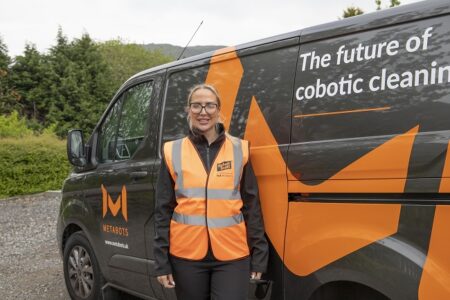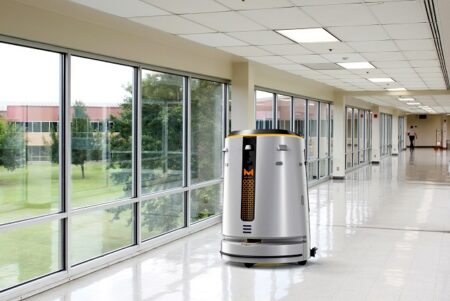Benefits of technology in cleaning: what education can learn from cobotics
We look at the ways technology – such as floor-cleaning robots – can help to keep educational facilities clean and hygienic

Kristal Goodwin, national sales manager for Robert Scott’s cobotics division
Educational facilities can provide a range of unique challenges for estates and facilities management professionals, from ensuring high-footfall locations are always safe and clean despite hundreds of young people moving from class to class, to making sure cleaning and maintenance regimes fit around class timetables.
Here, Kristal Goodwin, national sales manager for Robert Scott’s cobotics division, explores how cutting-edge cleaning robots could be the perfect partner for operatives working in these environments.
A growing trend
The cleaning sector is experiencing a significant transformation with the introduction of advanced robotics and intelligent management systems.
Smart connected technologies, the rise of the Internet of Things, and the development of AI have all made the switch to automated systems more straightforward.
Household-name brands have helped boost adoption within the consumer sector and now the commercial cleaning sector – not least in educational settings – is beginning to gain similar momentum.
This adoption is also being seen across Google Trends, which have shown a decline in inquiries for ‘deep cleaning services’ over the course of 2021 and 2022, with searches for ‘robot vacuum’ growing by 120%.
These technological innovations offer clear advantages and are particularly beneficial in environments requiring regular sanitation. Educational facilities, for example, represent a unique setting where autonomous cleaning robots can enhance cleanliness and safety in spaces used by both students and staff.

Robotic cleaning solutions offer an efficient solution for large education buildings
Integrating robots
There are a variety of robotic cleaning solutions available on the market today, each with its own benefits and limitations.
Among the various approaches, cobotics – where robots collaborate with human workers – stands out as a particularly-promising field.
In educational environments, cobots are invaluable for managing the cleaning of expansive areas such as hallways, assembly rooms, and sports halls.
They not only achieve consistently-high cleaning standards, but machines also complement human labour by freeing up staff to focus on targeted cleaning tasks, such as spot cleaning and deep sanitisation.
And cobotics help to narrow the gap where cleaning staff shortages are concerned.
Cleaning, waste disposal, and other facilities management industries were expected to create 93,000 new jobs by the year 2024 according to the British Cleaning Council. However, 29% of these positions have been classified as ‘hard to fill’.
These staff challenges are being echoed across the educational sector, with 82% of facilities reporting shortages of cleaning staff, according to a UNISON survey.
Adoption of technology provides tools that help cleaning operatives do more in the time they have, and by handling fewer monotonous tasks, operatives can gain greater job satisfaction which, in turn, supports better retention levels.
Combining cleaning robots with human workers results is a much-more-efficient, flexible, and inclusive approach than systems designed solely to replace human labour.
Equipped with state-of-the-art sensors and artificial intelligence, cobots help to avoid redundant cleaning efforts and conserve resources such as water and detergents, while also minimising site management maintenance costs.
The benefits
These machines are expertly designed to ensure an optimal clean and boast user-friendly operation, ideal for maintaining large, open spaces that ordinarily would take a lot of human time to do the same job.
Take, for instance, autonomous floor scrubber driers. They can come equipped with a variety of attachments capable of scrubbing, sweeping, polishing, and drying a floor, with the latter a key aspect to ensuring that accidents from wet floors are eliminated.
It is important to look for a machine that is engineered with precision navigation, can clean close to the edge of the room, and can detect objects, even if very small. Additionally, they should feature advanced obstacle avoidance to keep students and the facility safe and free from damage.
Machines with a zero-degree turn radius will manoeuvre into and clean tight spaces. Equally, operatives do not need to be tasked with disposing of wastewater and refilling with freshwater during cleans, so opting for machines that handle this, as well as charging, by autonomously returning to its integrated docking station will bring the most benefit.
Furthermore, these machines can be programmed to carry out cleaning tasks when schools are closed to ensure continuous floorcare is conducted without disruption to the educational process.
Estates and facilities managers can also benefit from intelligent performance data capture and tracking features.
For example, they can optimise cleaning schedules based on comprehensive data, such as area coverage and operation times, and set benchmarks and evaluate performance against established KPIs for continuous improvement.
And machines that offer a simple user interface and tamper-proof control panel will ensure only those who are trained and granted access can operate the machine.
Cobotic solutions generally use less cleaning products and water than traditional floor cleaning approaches. In fact, some require no water whatsoever, using bacteria-removing microfibre to clean floors. This helps reduce slip risks as well as cutting down on wastewater.
Modern battery-charging cobots can be powered for as little as 35p per hour, with a battery life of up to 20 hours.

Easy to introduce
Cobotic machines with user-friendly design will ease the transition to advanced cleaning technology.
Users typically find that with just a brief training period, they can operate the machines with confidence and skill.
Working with a supplier that has dedicated cobotic expertise will ensure a seamless onboarding process through comprehensive training, in-personal installation of the equipment, and ongoing support for troubleshooting and maintenance.
Simple tasks such as wiping and inspecting attachments and flushing out the hose should be all that is required by users.
In addition, existing technology is sophisticated enough that major infrastructure changes should not be needed to introduce cleaning robots.
Practical lessons
Another somewhat-unconventional benefit of cleaning robots is their capacity to fascinate and intrigue.
Educators constantly seek resources that can captivate and educate students in dynamic ways.
Integrating state-of-the-art intelligent cobots into cleaning routines within educational institutions offers an engaging, real-world illustration of technology in action.
For students delving into subjects like physics, engineering, mathematics and ICT, these autonomous cleaning robots can serve as tangible case studies of the principles they’re learning in class.
Cobotic cleaning systems offer an exciting future across a range of sectors.
In educational settings, they offer some particular benefits: from reducing disruption to students, to inspiring the next generation of engineers.
